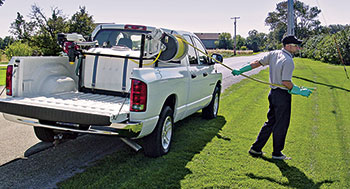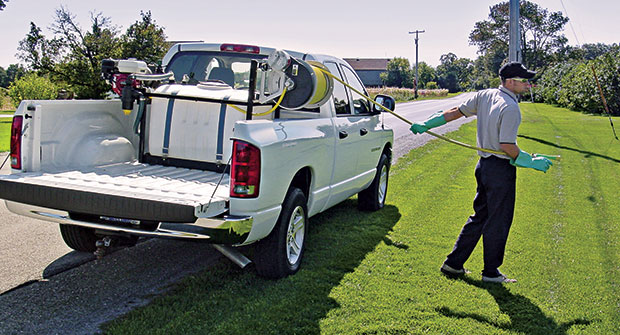
It’s an easily forgotten piece of equipment — a simple metal drum with rails and a motor or spring that retracts hoses for proper storing. And with proper, basic maintenance, reel users can safely forget about their equipment for years, manufacturers say.
“We don’t really have any problems with the reels until they get some age on them,” says Brian Nance, president and owner of H&H Farm Machine Co., a Monroe, N.C.-based maker of spray equipment for farms, golf courses, greenhouses and landscape systems. “That’s what we like about them.”
Jennifer Wing, marketing manager for Hannay Reels, says manufacturers design reels to survive harsh winters and hot summers, deal with caustic chemicals and withstand heavy use and vibration faced from being mounted on pickups. While no piece of equipment lasts forever, there are basic things users can do to extend the lives of their reels.
Teddy Mathis, sales manager at Graham Spray Equipment, agrees. Users taking the following advice can expect long-term, low-cost performance from their reels.
1. Get the right reel
“Know what you’ll be using the reel for, the fluid you’re running through it and the pressures and temperatures you’ll be using for the application,” Wing says.
If the reel isn’t rated for caustic chemicals, it could leak or crack. If your spraying application requires high pressure, standard reels could leak or fail. Also, with high pressure, unspool the entire hose before pressurizing the system. If the hose is still on the reel, pressurizing it could crush the reel’s wheel.
2. Keep it clean
Mathis explains that “reeling the hose back up in a somewhat neat manner” will distribute force across the wheel.
Nance suggests users “take a rag, and run the hose through that rag while they’re rolling it back up. That way, dirt and those kinds of things don’t make their way back home to the reel.”
3. Take it easy
Mathis says some crew members will pull on hoses that are already fully extended, hoping to get another inch or two of play rather than moving a truck. That puts pressure on the connector between the hose and the reel.
“Pulling the hose as far as possible can damage the reel or (cause) a massive leak,” Mathis adds.
Wing explains that even though reels have spring-powered or mechanical systems to retract hoses, users can’t just let go of the hose and hit retract.
“You need to walk the hose back to the reel,” Wing says. “Just letting go could cause damage to the reel and injury to anyone standing nearby.”
4. Inspect often
Leaks can be indicators of bigger problems, so look out for liquid pooling under reels, Mathis and Wing say. Mathis suggests visually inspecting reels daily, paying extra attention if you spot a leak.
Wing adds, “There are different kinds of rewind options, brake systems and locks, so know how they operate to make sure they’re working correctly.”
Motors or bearings that are starting to fail will often make lots of noise, so pay attention to grinding sounds or any new sounds coming from moving parts on reels.
For truck-mounted reels, check bolts frequently to make sure they’re tight, Nance says. Trucks are constantly vibrating, and even the best-installed equipment can get loose following heavy use.
5. Grease and oil
Powered reel systems have bearing, chains and other moving parts that require proper lubrication. Inspecting those parts and adding oil or grease when necessary can keep them working well, Mathis says.
Wing says basic care can protect investments in equipment for a long time.
“Maintenance is the key for any kind of mechanical equipment,” Wing says. “The chains, if they start looking loose, you can tighten those up. The reels are designed to withstand day-in and day-out use. They do require minimal maintenance checks, but if you keep up with those, they’ll last for a very long time.”


